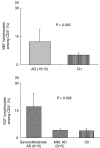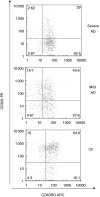Analysis of circulating gammadelta T cells in children affected by IgE-associated and non-IgE-associated allergic atopic eczema/dermatitis syndrome
- PMID: 15958077
- PMCID: PMC1809419
- DOI: 10.1111/j.1365-2249.2005.02813.x
Analysis of circulating gammadelta T cells in children affected by IgE-associated and non-IgE-associated allergic atopic eczema/dermatitis syndrome
Abstract
Recent studies have suggested that not only alphabeta(+) T cells, but also the less common gammadelta(+) T cells may play a role as effectors and immunoregolatory cells in the development and perpetuation of allergic inflammation. The objective of this study was to focus on the role of gammadelta(+) T cells in atopic dermatitis (AD), a chronic relapsing inflammatory disease of the skin, often associated with allergic bronchial asthma. The present study employed flow cytometric analysis to compare numbers and phenotypic characteristics of gammadelta(+) T cells in the peripheral blood of children with atopic dermatitis and age-matched healthy controls. The percentage of circulating Vgamma 9Vdelta2(+) T lymphocytes was significantly increased in AD patients with respect to the age-matched controls, with a positive correlation with clinical score severity. The prevalent phenotype in both AD patients and controls was CD45RO(+), with no differences observed in the percentage of Vdelta2(+) CD45RO(+) between these groups. Conversely, memory CD45RO(+) CD62L(+) Vdelta2(+) lymphocytes were significantly lower in AD patients. Furthermore, naive circulating Vdelta2(+) T lymphocytes were significantly lower in AD children than in aged-matched controls. No correlation was observed between circulating Vgamma 9Vdelta2(+) expansion and IgE serum levels. It was concluded that an association exists between the levels of circulating gammadelta(+) T lymphocytes and atopic dermatitis, with a positive correlation with clinical score but no link with IgE serum levels. The pathophysiological role of gammadelta T lymphocytes in atopic dermatitis awaits further investigation.
Figures



References
-
- Wuthrich B. Clinical aspects, epidemiology and prognosis of atopic dermatitis. Ann Allergy Asthma Immunol. 1999;83:464–70. - PubMed
-
- Wollenberg A, Bieber T. Atopic dermatitis: from the genes to skin lesions. Allergy. 2000;55:205–13. - PubMed
-
- Leung DYM. Atopic dermatitis: new insights and opportunities for therapeutic intervention. J Allergy Clin Immunol. 2000;105:860–72. - PubMed
-
- European Allergy White Paper Update. Brussels, Belgium: UCB Institute of Allergy; 2000. Allergic diseases as public health problem in Europe.
MeSH terms
Substances
LinkOut - more resources
Full Text Sources

